Alberta labels itself as “wild rose country”, and Banff National Park is a shining part of it. The park has many species that provide a vivid display of color to the natural landscape. In this article you will read all you need to know about wildflowers in Banff.
It’s like an extra dash of beauty: wildflowers in Banff National Park. A natural way to decorate an already stunning environment. Banff has a lot of wildflowers, and a lot of different kinds of wildflowers, for that matter.
Their beauty makes for extremely pretty photographs, so if you’re heading out to see wildflowers, don’t forget to bring your camera. At the end of this post, I have included some wildflower photography tips to help you get the most out of your pictures of blooming meadows and colorful lakeshores.
Let’s see what wildflower beauty Banff National Park has to offer!
Best Times of the Year to See Wildflowers in Banff
Timing is crucial when planning a trip to Banff to admire its wildflowers. The peak flowering time in Banff National Park ranges from mid-July to mid-August at all elevations. During this period, you can expect to see various colorful flowers.
In the late spring season, specifically late May, you can spot some early blooming flowers on the trails around Banff townsite. These include prairie crocus, violets, clematis, shooting stars, calypso orchids, and even strawberries.
As June arrives, other wildflowers appear with spotted saxifrage, wolf willow, northern coral-root, cow parsnip, red osier dogwood, Indian paintbrush, yellow dryas, and wild roses, the province’s floral emblem.
However, the weather and climate can significantly impact the blooming times of flowers. An unusually cold or wet spring may delay the flowering season. At the same time, an early warm spell could lead to earlier blooms.
Other factors that determine the blooming period are elevation and temperature.
Banff’s Wildflowers Regions
The wildflowers of Banff National Park grow in three different regions, each with its own characteristics, allowing different kinds of wildflowers to thrive.
These regions are:
- Montane (lower elevation)
- Subalpine (medium elevation)
- Alpine (higher elevation)
1. Montane Region
The Montane region in Banff National Park is characterized by its moderate elevation, typically ranging from around 1,400 meters (4,600 feet) to 1,800 meters (5,900 feet) above sea level.
This zone is a critical transition between the lower elevations and the higher alpine and subalpine regions. You’ll find a diverse range of plant life in the Montane zone, including various wildflowers.
Wildflowers in the Montane region are well-adapted to the changing seasons and temperature fluctuations. Many species bloom in spring and summer when the weather is milder, and the growing conditions are favorable. Some common wildflowers in Banff National Park’s Montane zone include violets, wild roses, paintbrush and prairie crocus.
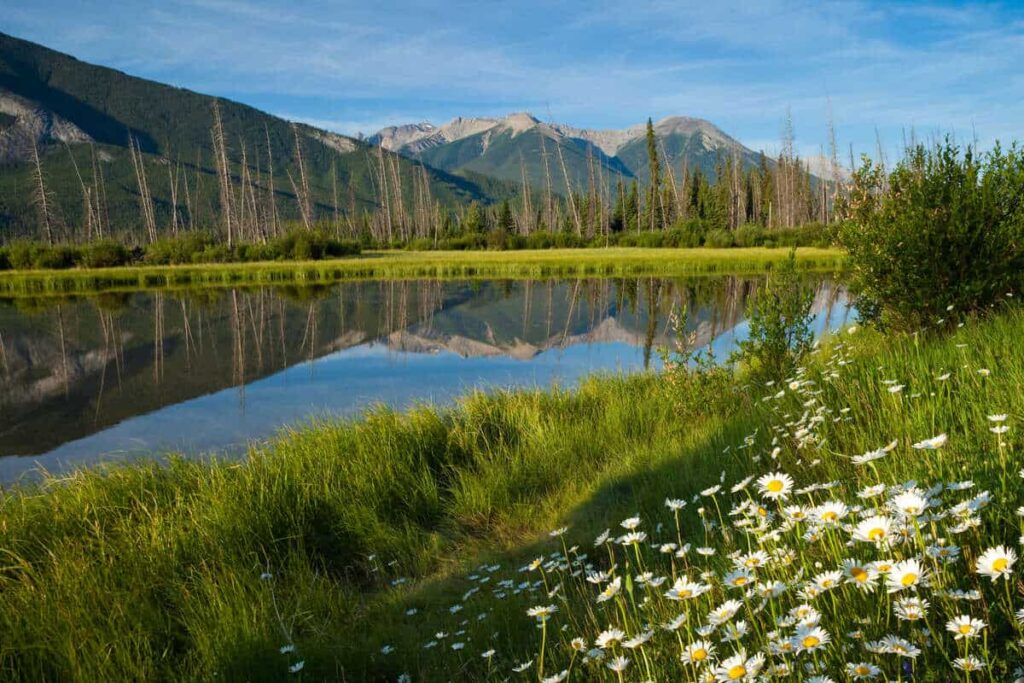
2. Subalpine Region
The subalpine region lies between the montane and alpine zones, typically ranging from about 1,400 meters (4,600 feet) to 1,800 meters (5,900 feet) up to the tree line, which is around 2,400 meters (7,900 feet) in Banff National Park. This zone is characterized by dense forests and a mix of coniferous and deciduous trees, with the alpine environment above the tree line.
Subalpine wildflowers enjoy a more extended growing season and milder temperatures than the alpine region. This allows for a more diverse array of wildflowers to flourish. In the subalpine zone of Banff National Park, you can find an assortment of wildflowers such as calypso orchids, white camas, clematis, Fireweed, and Rocky Mountain columbine.
3. Alpine Region
The Alpine region is situated at higher elevations, typically ranging from about 1,800 meters (5,900 feet) to 2,400 meters (7,900 feet) above sea level. This zone is characterized by harsher conditions, including colder temperatures, strong winds, and a shorter growing season.
Due to these challenging conditions, the diversity of plant life decreases. However, several unique and hardy wildflowers still thrive in the alpine environment.
Alpine wildflowers are known for their ability to withstand extreme weather conditions. Some examples of alpine wildflowers in Banff National Park include the alpine forget-me-not, shooting stars, alpine avens, and various species of dwarf willows.
Top Locations for Wildflower Viewing
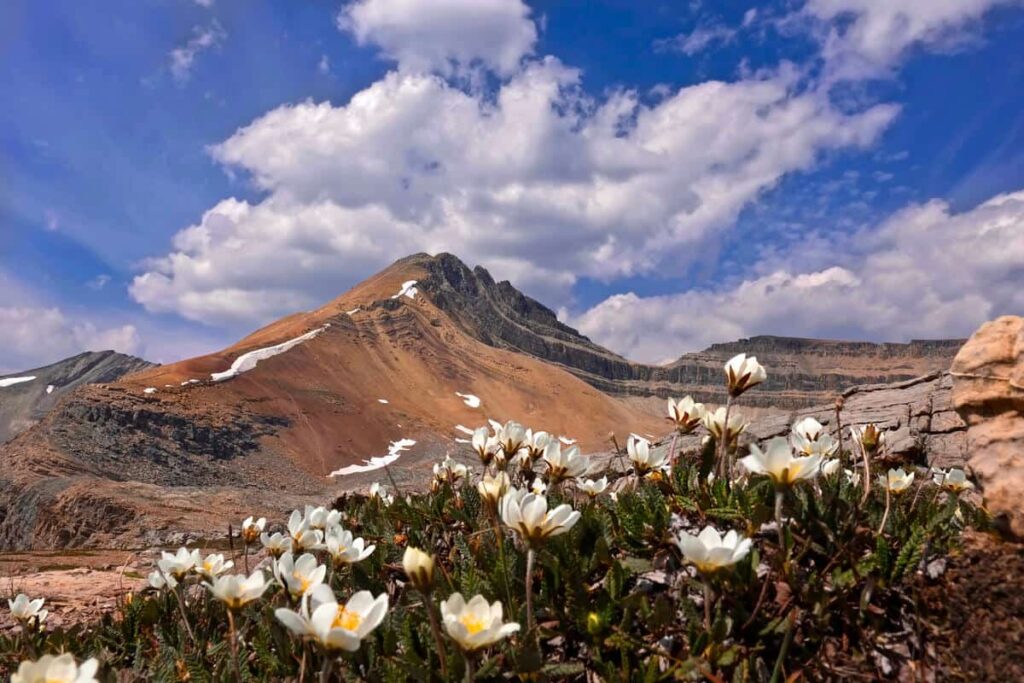
Below I listed some locations in the park known for their vivid display of wildflowers. I also included a map that indicates the listed areas.
- C-Level Cirque Hiking Trail
- Lake Minnewanka
- Stewart Canyon
- Johnson Lake
- Tunnel Mountain Summit
- Bow Falls
- Sundance Canyon
- Johnston Canyon
- Sunshine Meadows
- Healy Pass
- Molar Meadows
- Lake Louise
- Helen Lake
- Saskatchewan River Crossing
Wildflowers Species to Spot in Banff
Banff National Park is home to a diverse range of wildflowers. Here are some of the most common and beautiful wildflowers species you might encounter.
Alpine Forget-Me-Not (Myosotis alpestris)
The Alpine Forget-Me-Not is a charming and iconic wildflower of Banff National Park. It has vibrant blue blossoms and five delicate petals. This low-growing perennial thrives in the park’s alpine meadows and rocky slopes, showcasing its resilience to the harsh mountain environment.
The name “Forget-Me-Not” originates from the enduring legend of a knight who, while picking the flower for his love, fell into a river and threw the bouquet to her, shouting, “Forget me not!” The flower has since symbolized everlasting love and remembrance.
Calypso Orchids (Calypso bulbosa)
Calypso Orchids, or Fairy Slippers, are delicate flowers in Banff National Park. These orchids have pink, purple, or white blooms and intricate patterns. They often thrive in shaded areas, such as the forest undergrowth, where they rely on specific mycorrhizal fungi for growth—a fine example of the delicate and complex relationships between plants and fungi in the park’s ecosystem.
Clematis (Clematis occidentalis)
Clematis, also known as Western Blue Virginsbower, is a striking vine that climbs and adorns Banff’s rocky slopes and trees. It has white or light purple flowers. As a climbing plant, clematis demonstrates its adaptability.
Common Yarrow (Achillea millefolium)
The Common Yarrow is a widespread wildflower in Banff National Park. It features delicate, feathery leaves and clusters of small, white flowers. This versatile plant has been used for medicinal and culinary purposes for centuries. In addition to its practical uses, the Common Yarrow attracts pollinators like bees and butterflies.
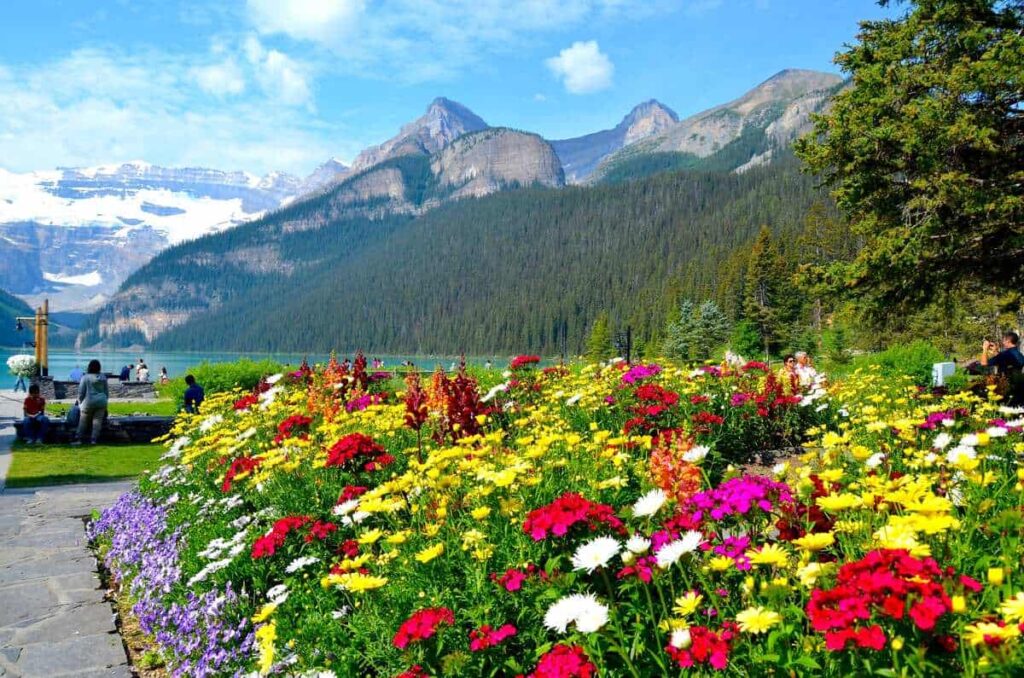
Cow Parsnip (Heracleum maximum)
Cow Parsnip is a robust plant in Banff National Park. Its tall stature and umbrella-like clusters of white flowers make it a notable sight along roadsides and riverbanks.
Cow Parsnip plays a crucial role in the park’s ecosystem, providing food and habitat for various insects, birds, and small mammals.
Handle this plant cautiously, as its sap can cause skin irritation when exposed to sunlight.
Fireweed (Chamerion angustifolium)
Fireweed is a charismatic wildflower that quickly colonizes areas of Banff National Park, recovering from wildfires or disturbances. Its tall, spiky stalks are adorned with bright pink to purple flowers.
As a pioneer species, Fireweed plays a vital ecological role in restoring disturbed ecosystems, providing essential nectar for pollinators, and offering sustenance to wildlife like moose and deer.
Indian Paintbrush (Castilleja spp.)
Indian Paintbrush is a wildflower that showcases a riot of colors. Its striking red, orange, or yellow bracts surrounding tiny flowers resemble paintbrushes dipped in vibrant hues, earning it the common name “Indian Paintbrush.”
As a hemiparasitic plant, it derives some nutrients from nearby host plants while still photosynthesizing. This unique adaptation allows it to flourish in various habitats and elevations within the park.
Northern Coral-Root (Corallorhiza trifida)
The Northern Coral Root is a fascinating wildflower. Unlike most plants, it does not contain chlorophyll and cannot photosynthesize. Instead, it depends on mycorrhizal fungi in the soil for sustenance.
You can find its reddish-brown or pale pink flowers emerging from the forest floor, adding an air of mystery to the park’s understory.
Paintbrush (Castilleja spp.)
The Paintbrush wildflowers in Banff National Park are a striking sight that adds a splash of vivid colors to the landscape. These tall, showy plants feature spikes of red, orange, yellow, or pink bracts surrounding tiny flowers, resembling a painter’s brush dipped in vibrant hues.
Hemiparasitic plants draw nutrients from nearby host plants while also photosynthesizing independently.
Prairie Crocus (Anemone patens)
Prairie Crocus, Pasqueflower, is a cherished and early-blooming wildflower. Its purple, lavender, or white flowers emerge as soon as the snow starts to recede, announcing the arrival of spring on the prairies.
This beautiful flower is very resilient, as it withstands the harsh mountain climate to bloom.
Red Osier Dogwood (Cornus sericea)
Red Osier Dogwood is a visually striking shrub, especially during winter when its bright red stems create a vibrant contrast against the snow. Come spring, it produces clusters of white flowers, attracting pollinators like bees and butterflies.
The subsequent formation of small white berries provides a valuable food source for wildlife. This makes it a significant contributor to the park’s ecological food web.
Rocky Mountain Columbine (Aquilegia saximontana)
The Rocky Mountain Columbine is the provincial flower of Alberta and a cherished wildflower in Banff National Park. It has unique bi-colored flowers, blue petals, and white centers.
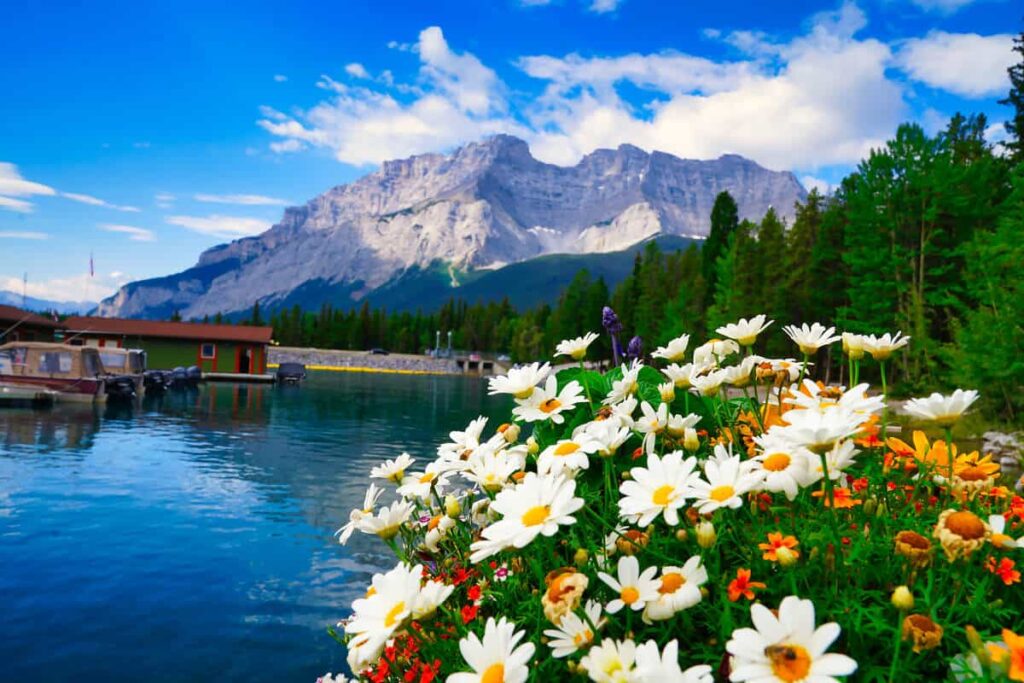
Shooting Stars (Primula spp.)
Shooting Stars are captivating wildflowers. These plants create a breathtaking spectacle on the forest floor with their nodding flowers, ranging from pink to lavender or white. They are named for their shape resembling shooting stars.
Spotted Saxifrage (Saxifraga bronchialis)
Spotted Saxifrage is a delightful alpine wildflower that graces Banff National Park’s rugged terrain. It has dainty white flowers adorned with striking purple spots. It can thrive in harsh mountain conditions, often in rocky crevices and high-altitude slopes.
Strawberries (Fragaria spp.)
Strawberries are a tasty addition to Banff National Park’s flora. These low-growing plants produce white flowers, giving way to the delicious red strawberries.
As fruit-bearing plants, strawberries provide food for animals such as birds, small mammals, and insects.
Violets (Viola spp.)
Violets add a splash of color to Banff National Park with their delicate and charming flowers. These low-growing plants feature heart-shaped leaves and vibrant purple, blue, or white flowers, creating a beautiful carpet across the forest floor.
Violets play a vital ecological role, providing essential nectar and pollen for early-emerging insects, such as bees and butterflies, making them valuable pollinator plants.
Wild Roses (Rosa spp.)
Wild Roses are cherished symbols of beauty and love in Banff National Park with their delicate petals and sweet fragrance. These lovely flowers can be found in various colors, including shades of pink and white.
Additionally, the rose hips that develop after flowering serves as a valuable food source for wildlife, ensuring that these graceful flowers contribute to the park’s ecosystem in multiple ways.
These wildflowers represent the biodiversity and ecological richness of Banff National Park.
Wolf Willow (Elaeagnus commutata)
Wolf Willow, or Silverberry, is a hardy shrub in Banff National Park. Its silvery leaves and small, inconspicuous yellow flowers may not immediately catch the eye, but its ecological significance is substantial.
As a nitrogen-fixing plant, Wolf Willow enriches the soil with essential nutrients, supporting the growth of other plant species in the region. Moreover, its berries provide a valuable food source for wildlife, including birds and small mammals. This unassuming shrub is vital in maintaining the park’s ecological balance and fostering biodiversity.
Yellow Dryas (Dryas drummondii)
Yellow Dryas is a low-growing wildflower in Banff National Park’s rocky areas. Its bright yellow flowers stand out against the rugged terrain, strikingly contrasting the surrounding landscape.
As one of the first wildflowers to bloom after the snowmelt, Yellow Dryas symbolizes the renewal of life and the arrival of spring in the park.
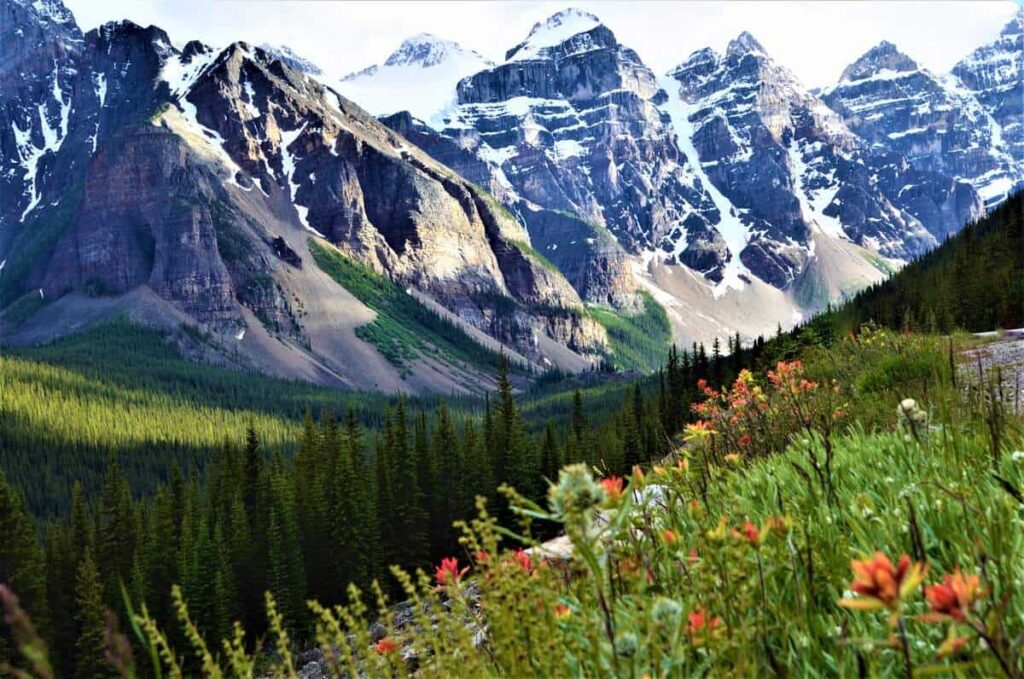
What Is the Most Common Wildflower Species Found in Banff National Park?
One of Banff National Park’s most commonly encountered wildflowers is the common yarrow (Achillea millefolium).
You can find this versatile plant in various habitats across the park, from open grassy areas to the shores of lakes such as Johnson Lake. The common yarrow is known for its beautiful, delicate white or pale pink blooms that form tight clusters atop tall stems.
Additionally, its foliage presents a feathery appearance, making the common yarrow easily recognizable.
Aside from its aesthetic appeal, the common yarrow is also a valuable plant for the local ecosystem. It attracts many pollinators, such as bees and butterflies. This way, it aids in maintaining the park’s biodiversity.
The yarrow is a hardy plant capable of thriving in harsh conditions. It is an essential contributor to Banff National Park’s wildflower population.
Which Areas of Banff National Park Have the Most Diverse Wildflower Populations?
Banff National Park is a treasure trove for wildflower enthusiasts, with various zones dotted across the park home to diverse wildflower populations. In this section, I will discuss some prime wildflower spots to enrich your Banff experience.
The North Shore of Johnson Lake boasts a wide variety of wildflowers. Nestled in a picturesque setting, this area allows you to admire the beautiful flora while soaking in panoramic views of the surrounding mountains.
Cascade Mountain and the Bow Valley Parkway are other notable locations. Open grassy areas below Cascade Mountain’s falls and along Bow Valley Parkway host an array of wildflowers.
Saskatchewan River Crossing is found in the northern part of Banff National Park. It is another must-visit area for wildflower enthusiasts. The region’s diverse flora adds a splash of color to the majestic landscape, making this a perfect spot for nature lovers and photographers.
Lake Agnes Trail is famous for hiking enthusiasts due to its wildflower accessibility. As this trail winds up to the historic Lake Agnes Tea House, travelers are greeted with breathtaking views of Lake Louise, making it a rewarding trek.
Wildflower Photography Tips
Wildflowers in Banff are breathtaking and worth photographing, especially with their spectacular surroundings. Here are some valuable tips to help you make the most of wildflower photography in the Canadian Rockies.
Firstly, choosing a location is crucial. Sunshine Meadows on the border of Banff National Park and Mt Assiniboine Provincial Park offers the most varied and accessible wildflower display in the entire Canadian Rockies. Another excellent spot for wildflower photography in Banff is Molar Meadows, known for its stunning landscapes and diverse plant life.
When photographing wildflowers, a tripod is essential. It allows for precise composition and framing and ensures your camera remains steady.
A sturdy, strong tripod that minimizes camera movement is highly recommended.
In terms of equipment, using a color intensifier filter is highly effective in capturing vibrant and bold colors. Pairing this with a warming circular polarizer can further enhance your wildflower photographs.
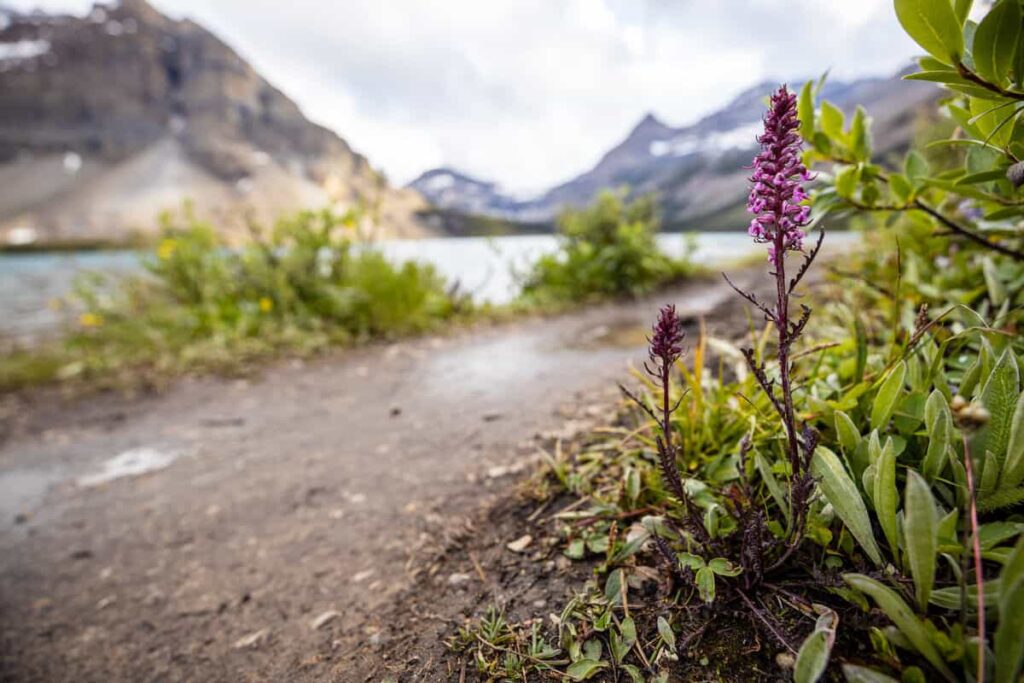
Are There Rules and Regulations for Picking Wildflowers in Banff National Park?
Picking wildflowers is not allowed in Banff National Park. This rule helps protect the delicate ecosystem and ensures the flowers can continue to thrive and reproduce.
Banff National Park also has protected areas where you must remain on designated trails to minimize environmental impact. Stay on the trails, especially in sensitive areas where wildflowers grow.
Guided Wildflower Hikes and Tours
Banff Hiking Tours
Banff Hiking Tours offers a variety of guided wildflower hikes to enjoy the beauty of Banff National Park. These hikes range from easy to moderate difficulty. Guides will take you through picturesque trails.
Some popular choices include the Johnston Canyon hike, which brings you past waterfalls, and the Sunshine Meadows hike, where you can enjoy breathtaking mountain views and alpine meadows filled with wildflowers. Your guide will provide informative tidbits about the local flora and fauna.
Discover Banff Tours
Discover Banff Tours also offers guided wildflower hikes, focusing on the best trails to witness and appreciate the natural beauty of Banff.
Notable options are the Tunnel Mountain hike, which takes you to a magnificent view overlooking the town of Banff and the valley, and the Lake Louise to Lake Agnes hike, where you’ll pass by vibrant wildflowers while admiring the pristine turquoise waters of Lake Louise. Guides will share interesting facts about the area.
Whichever tour you choose, don’t forget to bring your camera, as both Banff Hiking Tours and Discover Banff Tours will lead you through some of the most photogenic landscapes!

